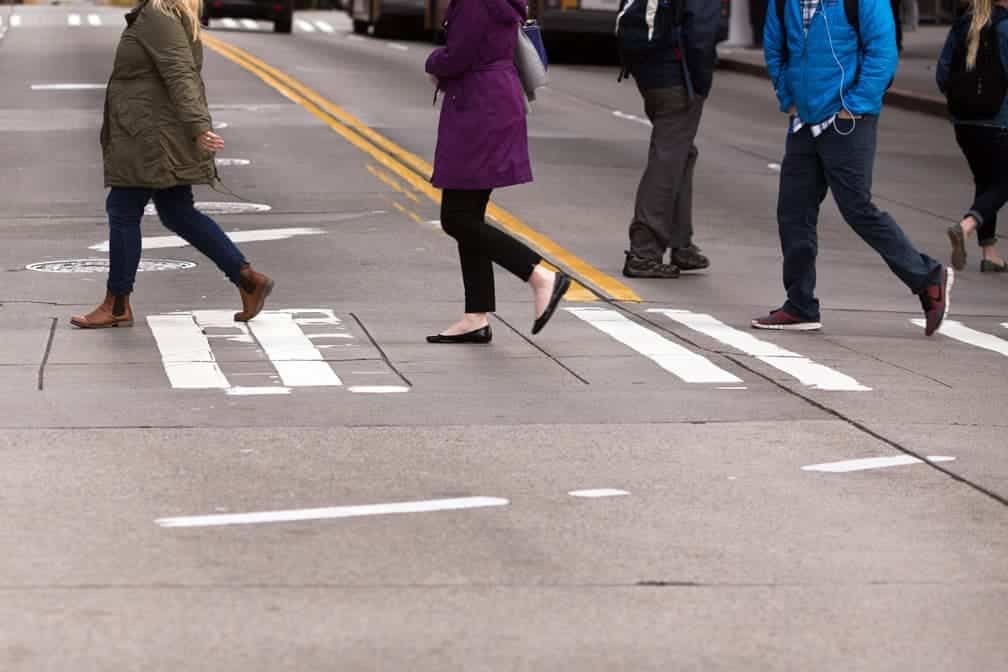It seems straightforward: people usually have the right-of-way over motor vehicles.
But most of our roadways were designed for the ease of cars, not the safety of pedestrians. As a result, drivers often forget—or simply disregard—the laws protecting the rights and safety of pedestrians.
Washington pedestrian traffic laws
Q: When do pedestrians have the right-of-way?
A: Pedestrians have the right-of-way at all crosswalks. Since every intersection is a crosswalk, drivers must stop for pedestrians if there are no traffic signals.
If another vehicle is yielding to a pedestrian at an intersection, don’t try to pass them.
-
- The operator of an approaching vehicle shall stop and remain stopped to allow a pedestrian or bicycle to cross the roadway within an unmarked or marked crosswalk when the pedestrian or bicycle is upon or within one lane of the half of the roadway upon which the vehicle is traveling or onto which it is turning. See RCW 46.61.235 (emphasis added).
- Whenever any vehicle is stopped at a marked crosswalk or at any unmarked crosswalk at an intersection to permit a pedestrian or bicycle to cross the roadway, the driver of any other vehicle approaching from the rear shall not overtake and pass such stopped vehicle. See RCW 46.61.235.

Q. What if a person crosses the street outside of an intersection?
A. Drivers have a duty to “exercise due care,” which means that you pay proper attention to the roadway, and act to avoid collisions.
In short, don’t hit people with your car. Honk the horn if a pedestrian doesn’t see you.
- Every driver of a vehicle shall exercise due care to avoid colliding with any pedestrian upon any roadway and shall give warning by sounding the horn when necessary and shall exercise proper precaution upon observing any child or any obviously confused or incapacitated person upon a roadway. See RCW 46.61.245 (emphasis added).

Q. When are cyclists considered pedestrians?
A. If a bicycle rider is on the sidewalk, then you treat them like a pedestrian.
Drivers yield to bikes and people on the sidewalk, and in crosswalks. Cyclists on the sidewalk yield to people walking.
- The driver of a vehicle shall yield the right-of-way to any pedestrian or bicycle on a sidewalk. The rider of a bicycle shall yield the right-of-way to a pedestrian on a sidewalk or crosswalk. See RCW 46.61.261 (emphasis added)

Pedestrian traffic laws for people walking
Legally, people or cyclists on the sidewalk can cross the street anywhere – including outside of a crosswalk. But they must yield to motor vehicles, and not just jump into traffic.
If people are between intersections with traffic lights or stop signs, they should only use the marked crosswalk to cross the street. See RCW 46.61.235 and RCW 46.61.240.
All drivers, cyclists, and people walking must obey traffic signals and traffic control devices. While people on the sidewalk have the right-of-way at a crosswalk, drivers don’t stop at a green light to let them cross.
Pedestrians must use sidewalks where available. If there are no sidewalks, people must walk on the left side of the road or shoulder. See RCW 46.61.250 (emphasis added).
This is a summary of the pedestrian traffic laws in the Revised Code of Washington state (RCW): it is not legal advice.

“Marcus” and a friend were walking home from school. To get home, the kids had to cross a street that the city of Seattle knew to be extremely dangerous for pedestrians.



